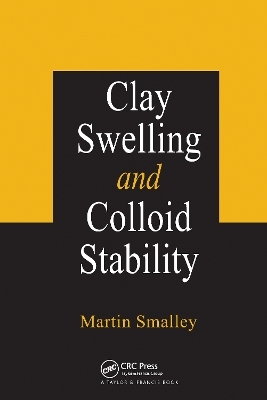
Clay Swelling and Colloid Stability
CRC Press (Verlag)
978-0-367-45374-9 (ISBN)
In a rare, over-the-shoulder perspective of a leading scientist’s own breakthroughs, Clay Swelling and Colloid Stability puts emphasis on two significant paradigm shifts in colloid science that explain particle interactions for charged plates, stacks, suspensions, and pastes as well as spherical colloids.
Martin Smalley first discusses the replacement of the DLVO theory with the Coulombic Attraction Theory to explain the existence, extent, and properties of the two-phase region of colloid stability. Using the n-butylammonium vermiculite system as his model clay system, the author clarifies the flaws of conventional theories and presents the experimental details that form the basis of his new theories. He provides rigorous derivations that place the new electrical theory for charged colloids on a firm foundation in statistical mechanics. The author illustrates why a new, quantitative bridging flocculation model for polymer-stabilized colloids must replace the depletion flocculation model. Smalley also examines the discovery of the "dressed macroion" structure of clay plates in solution, the structure of a bridging polymer, and the distribution of polymer segments, counterions, and water molecules in the interlayer region.
Based on the author’s own research and 36 publications in the field, Clay Swelling and Colloid Stability isa self-contained and intellectually satisfying account of the revolutionary process leading to a universally sound, and increasingly applicable, theory of colloid stability.
Martin Smalley worked as a professional research scientist from 1980 to 2000, with the exception of two years when he trained and worked as a physics teacher. In the late 1980s, after spells in theoretical physics at the Universities of Erlangen- Nürnberg and Oxford, he started investigating clays at the Physical Chemistry Laboratory, Oxford University, and the Department of Polymer Chemistry, Kyoto University. He became interested in polymers on an ERATO (Exploratory Research for Advanced Technology) project in Japan in the mid-1990s, and pursued his studies of colloids and polymers as a lecturer in the Department of Physics and Astronomy, University College London. This book summarizes the 36 papers (21 experimental, 15 theoretical) he has written on clays and colloids.
The n-Butylammonium Vermiculite System. The Coulombic Attraction Theory of Colloid Stability. Force-Distance Curves for Plate Macroions. Membrane Equilibria for Interacting Macroions. The Sol Concentration Effect in Clay Swelling. The Exact Mean Field Theory Solution for Plate Macroions. Criticisms and Refutations. The Structure of a Dressed Macroion in Solution. The Counterion Distribution between Charged Plates in Solution. Freezing Experiments on n-Butylammonium Vermiculite Gels. The Effect of Adding Polymers to the Vermiculite System. The Mechanism and Strength of Polymer Bridging Flocculation. The Structure of Bridging Polymers.
| Erscheinungsdatum | 03.12.2019 |
|---|---|
| Verlagsort | London |
| Sprache | englisch |
| Maße | 156 x 234 mm |
| Gewicht | 453 g |
| Themenwelt | Naturwissenschaften ► Biologie |
| Naturwissenschaften ► Chemie ► Physikalische Chemie | |
| Technik ► Maschinenbau | |
| ISBN-10 | 0-367-45374-6 / 0367453746 |
| ISBN-13 | 978-0-367-45374-9 / 9780367453749 |
| Zustand | Neuware |
| Haben Sie eine Frage zum Produkt? |
aus dem Bereich


